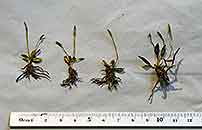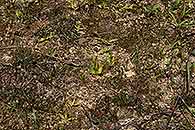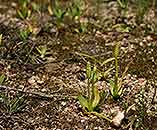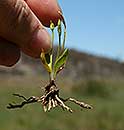Ophioglossum gomezianum Welw. ex A. Braun
Synonyms |
|
|---|---|
Common name |
|
Description |
Rhizome short, ellipsoid or oval, sometimes with a few short persistent leaf bases; roots descending, then horizontal, proliferous. Leaves up to 4 leaves but mostly 2, arising from ground level, held at 45-75° from the horizontal, bright to yellowish green. Stipe up to 2.5 cm long, subterranean for most of its length (80-100%), stipe:lamina ratio 0.4-0.8:1, stipe bases persistent. Sterile lamina 10-35 × 5-9.5 mm, lenght:width ratio 2.1-3.6:1, elliptic in outline, flat to shallowly concave above, apex pointed, base narrowly wedge-shaped. Fertile segment 3-9 cm long, inserted at or just above the base of the lamina, fertile spike:lamina ratio 1.9-2.3:1. Sporangia 8-14 pairs. |
Notes | Could be confused with O. sandieae which has a spindle-shaped rhizome and usually a single leaf with a petiole that is only for 40% subterranean. O. costatum has dull green leaves with a prominent pale midrib on the under surface. O. rubellum has dark green leaves that are held at up to 20° from the horizontal or appressed to the ground. |
Derivation | gomezianum: named after Mr. B. Gomez (1806-1877), Portuguese botanist. |
Habitat | Seasonally wet sheetrock mats, in shallow sandy soil, in full sun, in dry tropical woodland and savanna. |
Distribution worldwide | Africa, extending Eastwards to India. |
Distribution in Africa |
Angola, Burkina Fasso, Burundi, Central African Republic, Chad, Equatorial Guinea (incl. Bioko), Ethiopia, Ghana, Guinea, Ivory Coast, Kenya, Malawi, Mali, Nigeria, Senegal, Sierra Leone, South Africa, Sudan and South Sudan, Tanzania , Uganda, Zambia, Zimbabwe. |
Growth form |
Terrestrial. |
Literature |
|



